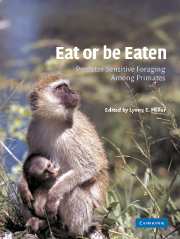Book contents
- Frontmatter
- Contents
- List of contributors
- Preface
- 1 An introduction to predator sensitive foraging
- PART I BIOLOGICAL VARIABLES
- PART II SOCIAL VARIABLES
- PART III ENVIRONMENTAL VARIABLES
- 12 Foraging female baboons exhibit similar patterns of antipredator vigilance across two populations
- 13 Foraging and safety in adult female blue monkeys in the Kakamega Forest, Kenya
- 14 Predicting predation risk for foraging, arboreal monkeys
- 15 Predator sensitive foraging in ateline primates
- 16 Antipredatory behavior in gibbons (Hylobates lar, Khao Yai/Thailand)
- Index
15 - Predator sensitive foraging in ateline primates
Published online by Cambridge University Press: 10 November 2009
- Frontmatter
- Contents
- List of contributors
- Preface
- 1 An introduction to predator sensitive foraging
- PART I BIOLOGICAL VARIABLES
- PART II SOCIAL VARIABLES
- PART III ENVIRONMENTAL VARIABLES
- 12 Foraging female baboons exhibit similar patterns of antipredator vigilance across two populations
- 13 Foraging and safety in adult female blue monkeys in the Kakamega Forest, Kenya
- 14 Predicting predation risk for foraging, arboreal monkeys
- 15 Predator sensitive foraging in ateline primates
- 16 Antipredatory behavior in gibbons (Hylobates lar, Khao Yai/Thailand)
- Index
Summary
Introduction
Many researchers have assumed that the risk of predation is a major factor – perhaps the most important factor – favoring sociality in primates (Alexander 1974, Dunbar 1988, Terborgh 1983, Terborgh and Janson 1986, van Schaik 1983). Testing this assumption has proven difficult because actual cases of predation on primates are rarely observed (Cheney and Wrangham 1987, Isbell 1994). None the less, if predation is a significant cause of mortality in contemporary primate populations, we would expect individual animals to be sensitive to the risk of predation and to adjust their behaviors in response to changing perceptions of that risk. We would particularly expect to see adjustments in the realm of foraging behavior – in decisions over where or when or for how long to forage, or over how vigilant to be while foraging – because the trade-off between avoiding predation and acquiring food is presumed to be fundamental for most taxa (Fraser and Huntingford 1986, Lima and Dill 1990). Although this trade-off has been studied extensively in many nonprimates (reviewed in Lima and Dill 1990), it has been investigated directly in only a handful of primate taxa (e.g., desert baboons: Cowlishaw 1997; brown capuchins: van Schaik and van Noordwijk 1989; wedge-capped capuchins: de Ruiter 1986, Robinson 1981; see also other chapters in this volume).
By virtue of their large body size, ateline primates – woolly monkeys, spider monkeys, howler monkeys, and muriquis – are less susceptible to predation than other, smaller neotropical primates, and thus predation risk is presumed to be a less important factor influencing sociality and subsistence behavior in these species.
- Type
- Chapter
- Information
- Eat or be EatenPredator Sensitive Foraging Among Primates, pp. 242 - 267Publisher: Cambridge University PressPrint publication year: 2002
- 23
- Cited by

